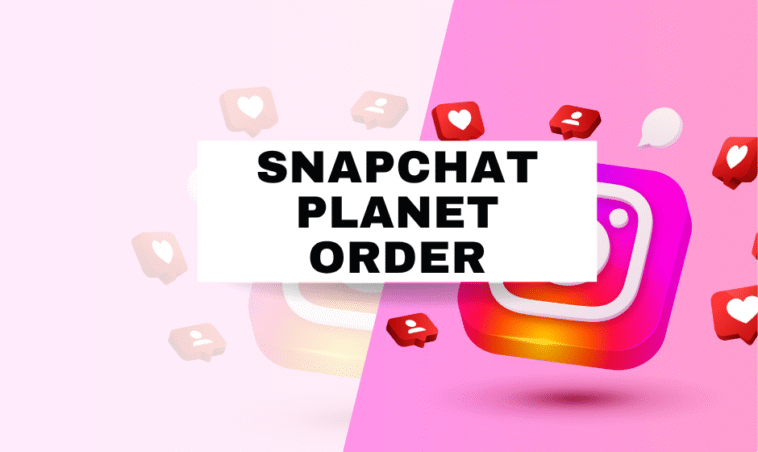The Snapchat Planet Order is more than just a fun visual—it’s an innovative way for users to understand their social dynamics within the app. Introduced as part of the “Solar System” feature under the Bitmoji integration, this interactive element assigns each user a specific planet that reflects their position in a friend’s closest circle. The closer you are to someone, the earlier your planet appears in the orbit around their sun. This gamified representation adds a new layer of emotional engagement to digital friendships.
At its core, the Snapchat Planet leverages real-time interaction data—such as snap frequency, chat volume, and story views—to determine where you stand among someone’s top contacts. Each of the eight planets (including Earth) corresponds to one of the eight closest friends, with Mercury being the #1 spot. This clever design not only makes Snapchat more engaging but also gives users a visual clue into who they interact with most frequently.
In the following sections, we’ll dive deeper into the mechanics behind the Snapchat Planet, explore how each planet correlates to friendship levels, and explain how users can interpret these positions meaningfully. Whether you’re curious about your own standing or want to better understand the relationships reflected in your Bitmoji solar system, this guide will offer valuable insights into one of Snapchat’s most intriguing features.
What Are Snapchat Planets?
The Concept Behind the Virtual Solar System
The Snapchat Planet Order exists within a broader framework known as Snapchat Planets or Snap Planets —a creative feature that transforms your close friendships into a personalized solar system. When integrated with Bitmoji, this feature maps out your top eight friends onto planets orbiting a central sun, which represents you. Each planet has a unique identity and symbolic meaning, reflecting the nature of your relationship with that particular friend.
Mercury, for instance, is the closest planet to the sun, signifying the person you interact with the most. Venus follows, representing the second-most frequent contact, and so on until Neptune, which indicates the eighth most active connection. These planetary placements aren’t arbitrary; they’re based on real-time interaction metrics tracked by Snapchat’s algorithm. The result is a dynamic, evolving map of your digital relationships that changes as your communication habits shift.
This virtual solar system on Snapchat serves both as a playful representation of social circles and as a subtle reminder of how our digital behaviors reflect real-life connections. By offering a visual metaphor for closeness, Snapchat enhances user engagement and encourages continued interaction. In essence, Snapchat Planets transform abstract numbers and statistics into a visually appealing and emotionally resonant experience.
Understanding how this system works starts with grasping the role of the Snapchat Planet—the key mechanism that determines where each friend lands in your Bitmoji universe.
How the Snapchat Planet Order Is Determined
The Algorithm Behind Friend Rankings
The Snapchat Planet isn’t randomly assigned. Instead, it’s determined by a proprietary algorithm that analyzes various types of interactions between users. This includes snaps sent and received, chats initiated, story views, and even shared screen time. Snapchat continuously monitors this data to provide the most accurate reflection of your closest contacts at any given moment.
Each interaction carries a certain weight, though the exact formula remains a closely guarded secret. However, it’s widely believed that direct messaging and snap exchanges have the highest impact. For example, sending multiple snaps per day to a friend might push them up the Snapchat Planet, while reduced communication could cause them to fall down the planetary hierarchy.
One important thing to note is that the Snapchat Planetis reciprocal. That means your position in a friend’s solar system may differ from theirs in yours. If you frequently send snaps to someone who doesn’t respond often, you might appear higher in their list than they do in yours. This asymmetry highlights the nuanced nature of digital friendships and the importance of mutual engagement.
Additionally, the Snapchat Planet updates regularly—typically every few days—ensuring that the planetary rankings stay current. This dynamic system keeps the experience fresh and relevant, encouraging users to maintain active connections with their closest friends. Whether you’re trying to hold onto the coveted Mercury spot or climb back up the ranks.
What Each Planet Represents in the Snapchat Solar System
Decoding Friendship Levels Through Planetary Positions
Each planet in the Snapchat Planetsymbolizes a different level of closeness in a user’s social network. Starting from Mercury—the closest planet to the sun—and moving outward to Neptune, the ranking reflects the intensity and consistency of interactions between users.
Mercury is the top spot, reserved for the person you communicate with most frequently. This individual receives the majority of your snaps, messages, and story views, making them your #1 best friend on Snapchat. Venus , the second planet, represents your next closest connection. While still highly active, this person interacts slightly less than the Mercury-ranked friend.
Moving further out, Earth marks the third position in the Snapchat Planet. Being on Earth suggests a strong bond, though not quite as dominant as Mercury or Venus. Mars , the fourth planet, typically belongs to a friend you interact with regularly but not daily. The fifth through eighth spots—represented by Jupiter, Saturn, Uranus, and Neptune—are occupied by those you engage with consistently, albeit less intensely than the top four.
It’s important to remember that these positions aren’t static. They evolve based on shifting communication patterns. A drop in interaction could lead to a demotion in the Snapchat Planet, while renewed engagement might boost a friend’s planetary status. This ever-changing dynamic adds an element of competition and curiosity to the feature, prompting users to monitor their standings and adjust their behavior accordingly.
By assigning symbolic meaning to each planet, Snapchat transforms raw interaction data into a meaningful, emotionally engaging experience. Whether you’re on Mercury or Neptune, your place in the Snapchat Planet offers insight into the strength and frequency of your digital relationships.
How to View Your Snapchat Planet Order
Step-by-Step Guide to Exploring Your Bitmoji Solar System
To view your Snapchat Planet, you first need to link your account with Bitmoji, Snapchat’s customizable avatar service. Once linked, your Bitmoji profile will be integrated into various Snapchat features, including the Snapchat Solar System . Here’s how you can access and explore your planetary ranking:
- Open Snapchat : Launch the app on your mobile device.
- Go to Your Profile : Tap your Bitmoji icon in the top-left corner of the camera screen.
- Access Bitmoji Settings : Scroll down to the Bitmoji section and tap “My Avatar.”
- Enable Solar System Feature : Ensure the “Solar System” option is toggled on. If not, activate it to begin seeing your planetary rankings.
- View Your Solar System : Return to your profile and look for the animated solar system graphic below your username. Tap on it to expand the view and see all eight planets.
Once inside the Snapchat Planet interface, you’ll notice each planet labeled with the corresponding friend’s Bitmoji and name. Tapping on a planet reveals details such as how long you’ve been in that position and how many snaps have been exchanged. You can also compare your solar system with a friend’s by visiting their profile and viewing their planetary setup.
It’s worth noting that visibility is mutual—if you can see a friend’s Snapchat Planet, they can see yours as well. This creates a transparent yet competitive environment where users can gauge their relative standing in each other’s social circles.
For the best experience, ensure your Bitmoji app is updated and that you grant Snapchat permission to sync your interactions. This allows the Snapchat Planetto remain accurate and reflective of your current communication habits.
Why the Snapchat Planet Order Matters to Users
Emotional and Psychological Impact of Planetary Rankings
The Snapchat Planet is more than just a novelty—it holds significant emotional weight for many users. Because it visually represents who you communicate with most frequently, the planetary rankings can influence self-esteem, foster friendly competition, and even affect real-world relationships.
For younger users especially, being ranked high in a friend’s Snapchat Planet can feel validating. Landing on Mercury—the coveted #1 spot—often brings a sense of pride and reinforces feelings of closeness. Conversely, slipping down the planetary hierarchy or noticing a drop in rank can lead to confusion, anxiety, or concern over the state of a friendship. Some users even admit to adjusting their behavior—sending more snaps or chatting more frequently—to maintain or regain a favorable position.
Beyond personal validation, the Snapchat Planet also introduces an element of social transparency. Since the rankings are mutual, users can compare their standings with others, leading to conversations about digital closeness and interaction patterns. While some find this openness refreshing, others may feel uncomfortable knowing exactly where they stand in someone’s social hierarchy.
Moreover, the Snapchat Planet subtly influences user engagement. Knowing that your planetary position can change based on activity levels encourages consistent interaction with top contacts. This gamification strategy not only boosts Snapchat usage but also strengthens digital bonds in a visually compelling way.
Ultimately, the Snapchat Planet taps into fundamental human desires for recognition, connection, and belonging. Whether you’re competing for Mercury or content with Neptune, your place in the solar system speaks volumes about your digital relationships.
Can You Influence Your Snapchat Planet Order?
Strategies to Improve or Maintain Your Ranking
While the Snapchat Planet is largely determined by an automated algorithm, there are several ways users can influence their position in a friend’s planetary lineup. Since the ranking is based on interaction frequency and engagement levels, strategic communication can help you climb—or at least maintain—your spot in the solar system.
One of the most effective methods is increasing snap and chat activity. Sending daily snaps, whether humorous images, voice notes, or video messages, helps reinforce your presence in a friend’s feed. Engaging in longer conversations rather than quick exchanges also signals stronger interaction, potentially boosting your ranking in the Snapchat Planet.
Another tactic is actively viewing and responding to stories. Regularly watching a friend’s Snapchat story and reacting with emojis or comments increases your visibility metric. Additionally, sharing your own stories frequently encourages reciprocation, keeping you top-of-mind and improving your chances of maintaining a high planetary position.
Timing also plays a role. Consistency is key—if you suddenly stop interacting with a friend who previously ranked you high, your position may drop. Therefore, maintaining regular communication—even if it’s brief—is crucial for holding your spot in the Snapchat Planet.
Lastly, using Bitmoji consistently ensures your avatar remains visible in the planetary interface. Since Bitmoji integration powers the solar system feature, staying active within the ecosystem helps reinforce your digital presence.
While there’s no guaranteed way to control your planetary ranking, adopting these strategies can significantly improve your chances of securing—or retaining—a favorable position in your friend’s Snapchat Planet.
Common Misconceptions About the Snapchat Planet Order
Separating Fact from Fiction
Despite its popularity, the Snapchat Planet is often misunderstood. Many users assume that their position in a friend’s planetary lineup is fixed or based solely on snap streaks. However, the reality is far more nuanced, and several myths persist that can lead to unnecessary worry or misinterpretation.
One common misconception is that being on Mercury guarantees exclusivity. In truth, multiple people can occupy Mercury in different friends’ solar systems, and it simply reflects the highest interaction level—not necessarily a romantic or exclusive relationship. Another myth is that planetary rankings are permanent. On the contrary, the Snapchat Planet updates dynamically based on ongoing communication, meaning a drop in engagement can quickly lead to a lower placement.
Some users also believe that the Snapchat Planet is influenced by third-party apps or manual adjustments. However, Snapchat has confirmed that the rankings are generated automatically based on internal metrics and cannot be altered manually. Additionally, there’s a widespread belief that disappearing messages affect planetary standings, but in reality, as long as interactions occur, message type doesn’t significantly alter the algorithm.
Finally, many users confuse the Snapchat Planet with Best Friends lists. While related, the two features operate differently. Best Friends highlight mutual top contacts, whereas the Snapchat Planet provides a tiered ranking system across eight distinct positions.
By dispelling these misconceptions, users can gain a clearer understanding of how the Snapchat Planet truly functions and avoid unnecessary stress over fluctuating rankings.
How the Snapchat Planet Order Reflects Digital Relationships
A Mirror to Modern Communication Habits
The Snapchat Planet serves as a fascinating reflection of modern digital relationships, offering insight into how users prioritize and maintain connections in the age of instant communication.
This feature highlights the shift from passive observation to active participation in digital friendships. Simply viewing a profile or liking a post won’t influence your standing—you must engage through snaps, chats, or story interactions to move up in the planetary rankings. As a result, the Snapchat Planet emphasizes quality over quantity, rewarding consistent communication rather than superficial gestures.
Moreover, the Snapchat Planet underscores the transient nature of digital relationships. Just as planets shift in orbit, friendships on Snapchat can rise and fall based on changing interaction patterns. This fluidity mirrors real-life relationships, where proximity and engagement play pivotal roles in maintaining closeness.
For many users, particularly teens and young adults, the Snapchat Planet acts as a digital barometer of their social lives. It fosters awareness of communication habits and encourages intentional efforts to strengthen bonds. Whether striving to reclaim a lost Mercury spot or appreciating a steady Neptune presence, users engage with their networks in a more conscious and meaningful way.
Ultimately, the Snapchat Planet captures the evolving landscape of digital intimacy, blending technology with emotional intelligence to redefine how we perceive and sustain friendships in the modern era.
Conclusion: Embracing the Power of the Snapchat Planet Order
The Snapchat Planet is more than just a playful feature—it’s a powerful tool that shapes how users understand and engage with their digital relationships. By translating complex interaction data into a visually intuitive format, Snapchat transforms abstract metrics into a meaningful representation of closeness. Whether you’re on Mercury or Neptune, your planetary position tells a story about your communication habits and the strength of your friendships.
Understanding how the Snapchat Planet works empowers users to take control of their digital presence and make informed decisions about their social interactions. From learning how rankings are determined to implementing strategies that help maintain or improve your standing, this feature encourages mindful engagement and stronger connections.





GIPHY App Key not set. Please check settings